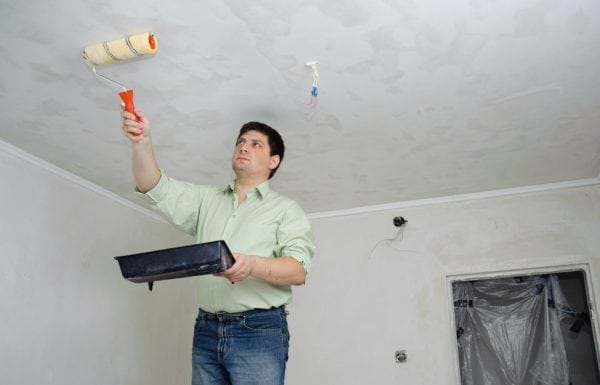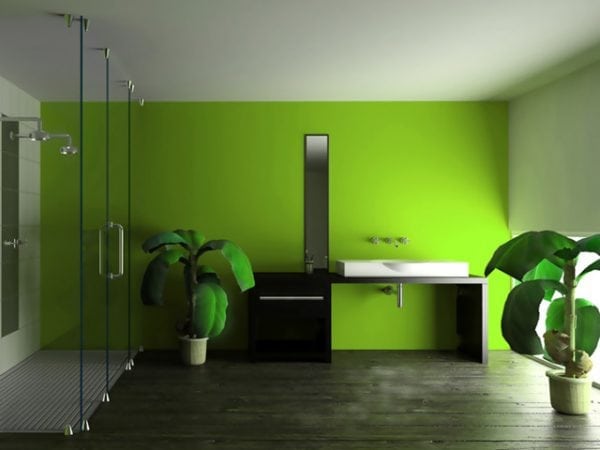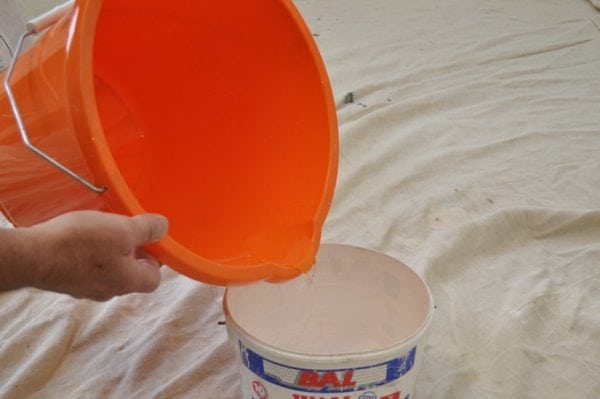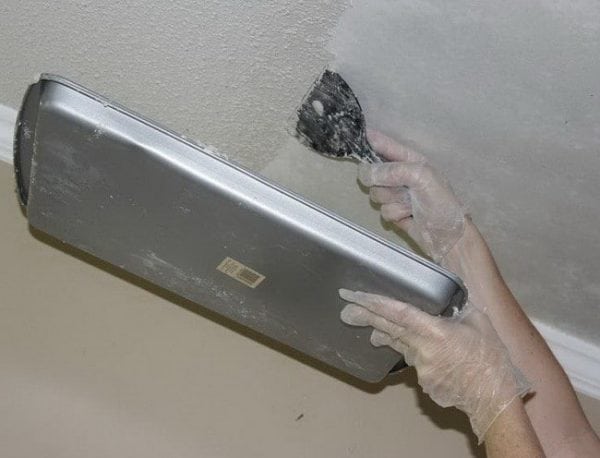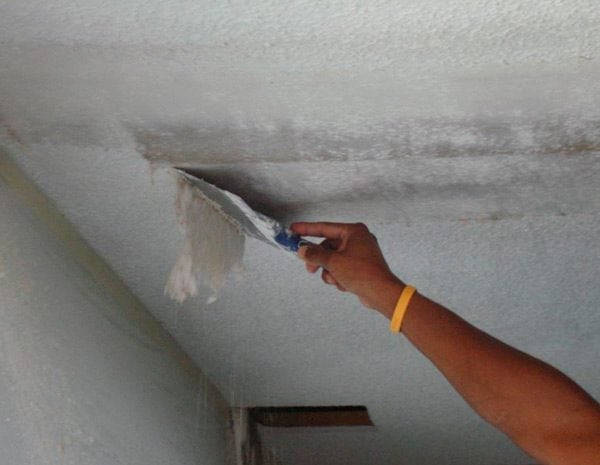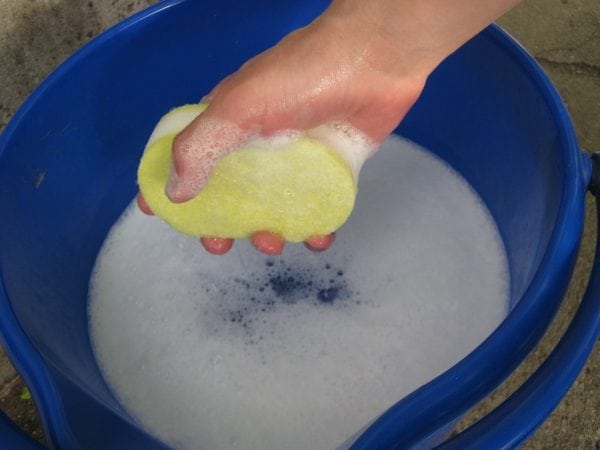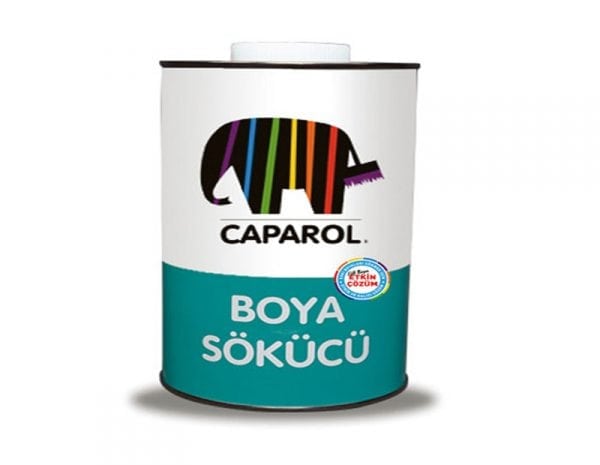Often during the repair, you need to remove the layer of old water-based paint to apply a fresh paint composition. It is not so difficult to do this if certain rules are followed. How to remove water-based paint from the ceiling or any other surface will be discussed in this article.
- The need to wash off the paint
- Paint Removal Methods
- Flushing with water
- Thermal and mechanical methods
- Flushing waterproof paint
- Other surface cleaning methods
- Chemicals for washing
- Cleaning paint from debris
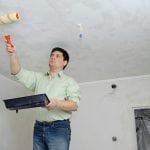
The need to wash off the paint
If the water-based paint adheres well to the surface, it is not necessary to remove it. In this case, a new layer can be applied directly over the old. However, in any case, it is necessary to clean the surface of dust and debris, as well as dry and apply a layer of primer.
Due to the primer composition, an adhesive coating forms on the surface, on which the paint will lie well. There are different types of soils, including those specifically designed for water-based compositions.
Old paint does not always adhere firmly to the surface; it may peel or bubble. In such cases, the paintwork layer must be washed off. Also, the removal of paint is inevitable in the event of a major overhaul or when it is planned to apply a completely different type of finishing material to the surface.
You can not do without removing the water-emulsion layer and, if necessary, painting with a paintwork composition of a sharply different color. For example, if the old layer is darker or too bright, it will probably have to be washed off.
to contents ↑Paint Removal Methods
Flushing with water
To remove water-based paint from the ceiling or wall, you will need the following tools:
- stepladder, steady table or stool;
- wide metal spatula;
- a roller (preferably with a sufficiently long handle);
- capacity (e.g. basin);
- brush with metal bristles;
- a film of polyethylene (in the absence of a film, newspapers can be used);
- safety glasses, gloves and a respirator.
The coating may be waterproof and non-waterproof. If a water-based paint-and-lacquer paint is resistant to moisture, it is useless to remove it with water, so in this case we will talk about washing out exclusively non-water-resistant compounds.
To wash off the old layer, do the following:
- We isolate all surfaces that are undesirable to contaminate with plastic film or newspapers.
- Wear safety glasses, gloves and a respirator.
- Pour warm water into a basin or other suitable container.
- We lower the roller into the water and draw it over the paint layer, which we were about to remove.
- A well-soaked coating is left to deaden for 10-15 minutes.
- We remove the softened paint with a metal spatula.
- If the paint in some areas has not become so wet so that it can be easily removed, once again wet the surface with water and work with a wire brush.
to contents ↑Note! There is no need to immediately wet the entire surface of a large area. It is very likely that when the turn reaches a certain site, it will dry by this moment.
Thermal and mechanical methods
You can also remove paint with a power tool or heat.In one case, you will need an electric drill with a grinding nozzle, in the other - a building hair dryer.
The grinding nozzle is a round brush with metal bristles. You can buy such a device on the market or in a building materials store. Thanks to the stiff metal bristles, even thick layers of waterproof paint that cannot be washed off with water can be removed. You can also use a grinder. The only significant drawback of the mechanical method is the significant amount of dust released during operation.
Thermal technique involves the use of high temperature to soften the paint layer. As a device for temperature exposure, a building hair dryer is used. This device works on the basis of the same principle as a household hair dryer, but the air temperature is much higher.
To remove paint, we heat the selected area until cracks appear on the coating. Cracked paint is then removed with a metal spatula. The remaining paintwork material is cleaned with sandpaper or a brush with metal bristles. Finally, thoroughly rinse and vacuum the surface.
to contents ↑The disadvantage of the thermal method is the need to purchase a building hair dryer. It is best to rent this device in a hardware store or ask friends for a while.
Flushing waterproof paint
As mentioned above, water-resistant paintwork cannot be washed off only with water. However, if at hand there is no more advanced toolkit (building hair dryer, electric drill, grinder), you can use methods that use both water and other improvised tools.
First way:
- We need a brush with hard teeth made of metal. With a brush it is necessary to make deep furrows in the paint layer.
- Next, we abundantly wet the scratched places to soften the layer of paint from the inside. We wait for 10-15 minutes, and then again apply water to the surface: the more the paint swells, the better. Do not forget to ventilate the room, since good air circulation in humid conditions contributes to the peeling of paintwork.
- We clean the surface of the old layer with a spatula.
The second way:
- In this case, you need wallpaper glue or paste. Apply the adhesive to the old layer and a sheet of thin paper. Next, the paper is well glued to the surface being cleaned.
- Let the glue dry.
- After the adhesive has dried, remove the paper with a spatula. Together with the paper, the ink will peel off. We remove the remains of the old layer with sandpaper.
Other surface cleaning methods
In addition to the above, there are alternative ways to remove water-based paint:
- Flushing with chemicals. An example is iodine, 200 milliliters of which is added to water. You can also use a soap solution. The paint will swell faster if you add alcohol or salicylic acid to the solution. The fact is that alcohol actively dissolves acrylates. Latex coatings dissolve due to exposure to chloroform and dichloroethane compounds. However, do not forget about the toxicity of these substances and the need to use protective equipment (gloves, goggles, a respirator), as well as room ventilation.
- You can hide the layer of old paintwork behind a suspended or suspended ceiling, as well as behind decorative panels. Of course, this method is applicable only with a sufficient ceiling height.
- You can also wash off the old layer with a paint shredder. With this jelly-like substance, treat the desired area and wait for the time specified by the manufacturer on the package.Next, the material is treated with solvent 646 and removed with a metal spatula. The advantage of the technique is the absence of dust pollution, and the disadvantage is the rather large time costs.
- In addition to destroyers, there are special washes. Such a substance is a liquid including a dimethyl chloride solvent, isopropyl alcohol, formic acid, or some other organic component. About 200 grams of flushing fluid will be needed per square meter of surface.
Chemicals for washing
There are many washing-up compositions on the market, but not all of them are suitable for surface treatment in rooms, as they are highly toxic. Of the compositions intended for internal work, the following can be distinguished:
- "Set Boya Sokucu" Turkish production. Rinsing helps soften the paintwork on concrete, wood and metal surfaces. "Set Boya Sokucu" is incompatible with plastic, as it corrodes the material. The composition is applied to the surface for 15-20 minutes. After the waiting period, the remaining paint is removed with a spatula. Cleaning is completed by surface treatment with a cellulose-based solvent.
- Flushing composition "Manor". The substance looks like a paste gel and can be used to remove water-based coatings from any surfaces other than plastic. The paint softens for approximately 10-15 minutes after applying the wash. The gel is characterized by safety for human health. At the end of the process, it is necessary to finish the material with some degreaser.
If you want to remove paint from plastic without damaging the surface, it must be taken into account that for each type of plastics different chemical compositions are used.
to contents ↑Cleaning paint from debris
When carrying out repairs, garbage often gets into the container with fresh paintwork. Usually this happens due to insufficiently thorough removal of dirt from the surface or tool. Do not use contaminated paintwork, because in this case it is impossible to ensure the proper quality of the paint. Water-based paint is not cheap, so instead of buying a new can, it is better to remove garbage from the tank. This is done as follows:
- We remove large pieces of garbage with our hands or, for example, with forceps. We remove particles of medium dimension with a sieve.
- In case of random mixing of paints and varnishes of different colors, mix them well. Next, take the right color in the right amount and slowly add it to the solution. The goal is to return the paint to its original color. However, it is worth noting here that tinting is possible only in a situation if we are dealing with the same compositions. For example, in no case should you mix oil and acrylic coatings.
- Debris can also penetrate quite deeply on a painted surface. In this case, cleaning the problem area with sandpaper with fine grain will help. Another layer of paint is then applied to the cleaned area. If the contamination is too noticeable, it may be necessary to apply a new coat of paint on the entire painted surface.
So, when choosing a method of cleaning the surface of water-based paint, it is necessary to take into account the type of coloring composition: is it waterproof. The easiest way to remove the old layer is flushing with water, and the most technologically advanced is the use of special chemicals.

